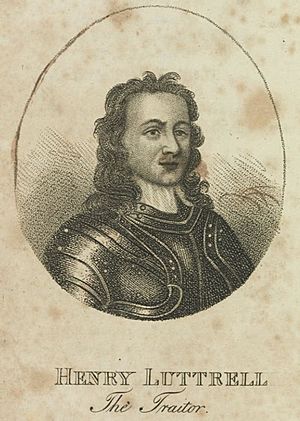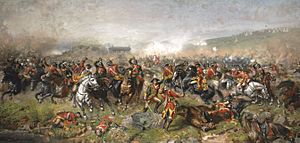Henry Luttrell (Jacobite commander) facts for kids
Quick facts for kids
Colonel Henry Luttrell
|
|
|---|---|

The Irish Magazine, Published by Walter Cox, Feb.-Nov. 1808, Jan. 1809 - July 1812 (plate from 1809)
|
|
| Born | c.1655 Luttrellstown, Clonsilla Parish, County Dublin, Ireland
|
| Died | 22 October 1717 |
| Cause of death | Assassinated (Shot) |
| Resting place | St Mary's Churchyard, Clonsilla, County Dublin, Ireland |
| Nationality | Irish |
| Occupation | Soldier, Politician |
| Spouse(s) | Elizabeth Jones |
| Children | Robert Luttrell, Simon Luttrell |
| Parent(s) | Thomas Luttrell |
Henry Luttrell (born around 1655 – died October 22, 1717) was an Irish soldier. He is known for his role in the Jacobite cause. This was a movement to bring King James II back to the throne.
Luttrell was a professional soldier. He served King James II in England. But James II was overthrown in 1688. After this, Luttrell continued to fight for James in Ireland. He became a General in the Irish Army.
In 1691, it was discovered he was secretly talking to enemy commanders. He was put on trial and sent to prison. Later, after the Treaty of Limerick, he was pardoned. The new rulers of Ireland, called Williamites, forgave him. He was even given the Luttrellstown estate. This land had been taken from his older brother, Simon Luttrell.
Luttrell wanted to lead a military group for William III of England. But this request was turned down. In 1717, Henry Luttrell was murdered in Dublin. His murder case was never solved.
Contents
Early Life and Beginnings
Henry Luttrell was born around 1655. He was the second son of Thomas Luttrell. His family owned Luttrellstown Castle in County Dublin, Ireland. They were a Catholic family.
Henry spent his younger years in Europe. During this time, he was involved in a duel in a place called Liège.
Serving King James II
In 1685, Henry Luttrell joined the army in England. He became a Captain in Princess Anne of Denmark's Regiment. In 1686, he was given command of the 4th Troop of Horse Grenadier Guards.
During the Glorious Revolution in 1688, many English army officers switched sides. They joined William of Orange. But Luttrell stayed loyal to King James II. He fought under Patrick Sarsfield at the Wincanton Skirmish in November 1688.
The War in Ireland

After King William took control of London, Luttrell went to Ireland. He joined the Irish Army. This army was still loyal to King James. It was growing very quickly. Luttrell and other Catholic officers joined this army. Many Protestant officers were removed.
Protestants in Ireland began to rebel. They said they were loyal to William of Orange. A small uprising in Bandon was quickly stopped. But a long Siege of Derry began. Luttrell was put in charge of a cavalry regiment. He also represented County Carlow in the Patriot Parliament. This was a special meeting called by King James.
In 1689, Luttrell became Governor of Sligo. This town had just been taken back from the enemy. He immediately started making the town's defenses stronger. Luttrell was a friend and supporter of Patrick Sarsfield. He agreed with Sarsfield that they should keep fighting. This was after the Jacobites lost the Battle of the Boyne in 1690.
A Controversial Figure
During the Battle of Aughrim, Luttrell's cavalry suddenly left the fight. This made many people suspect he was not loyal.
Later, during the Siege of Limerick, it was found that he was talking to the enemy. He almost faced a very serious punishment. But after the city surrendered, he switched his cavalry regiment to the Williamite side. As a reward, he received his older brother's lands, including Luttrellstown. He was also made a major general in the Dutch army.
Later Years and Mystery
On October 13, 1704, Henry Luttrell married Elizabeth Jones. They had two sons:
- Robert Luttrell (died 1727)
- Simon Luttrell, 1st Earl of Carhampton (1713–1787)
On the night of October 22, 1717, Luttrell was shot. He was in his sedan chair in Dublin. He died the next day, at 63 years old. The people who murdered him were never caught. Even though large rewards were offered, the case remained a mystery.
Years later, an attempt was also made to kill his grandson, Henry Luttrell, 2nd Earl of Carhampton. This grandson was also disliked by many. He sold Luttrellstown Castle in 1800. The family had owned it for almost 600 years. After the castle was sold, Colonel Luttrell's grave was opened, and his skull was damaged.

